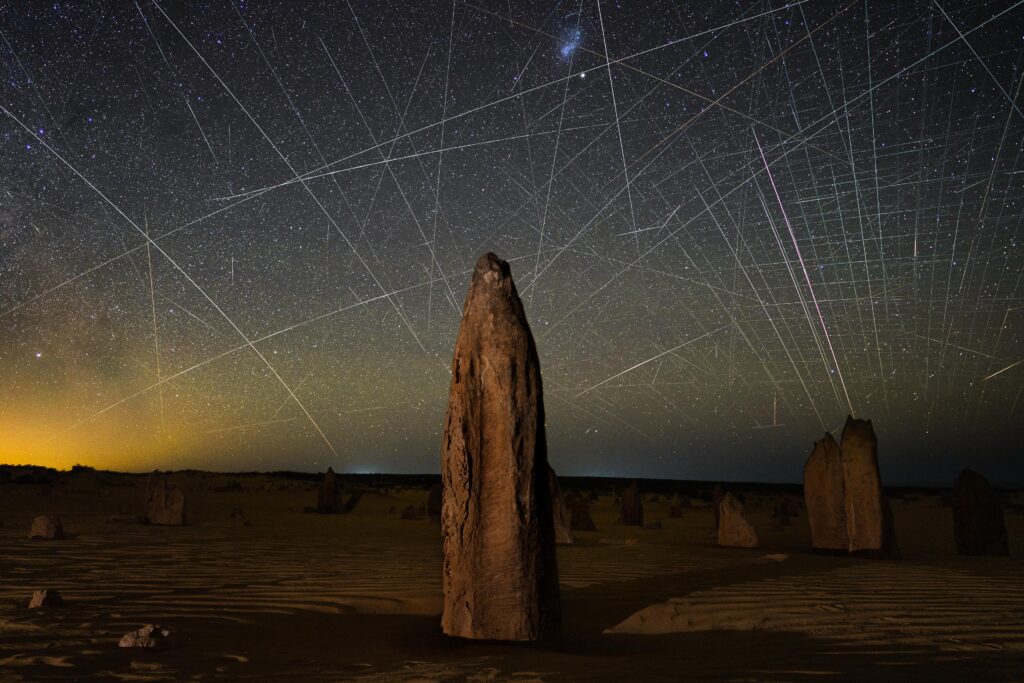While not my chosen field or profession, anyone that knows me is aware of how much I love astronomy. Space is endlessly fascinating to me; whether I’m scanning the awe-inspiring images sent back by the James Webb Space Telescope, or soaking up Matt O’Dowd’s explanations of complex physics concepts on PBS Space Time, I can’t get enough of space. Which makes me so incredibly frustrated and dismayed to see the ways that massive satellite constellations have interrupted Earth-based astronomical observations.

Typical communications satellites are in geostationary orbit, which allow them to stay in one spot relative to the Earth’s rotation and orbit around the sun; since these satellites aren’t moving very much across the sky, it’s much easier for astronomers to identify them and take them into account in their observational data. Satellite constellations, in contrast, orbit the Earth in satellite trains that travel across the night sky and are a nuisance at best to astronomers who are attempting to uncover valuable knowledge. The satellites force astronomers to take shorter exposures instead of longer, automated surveys; this means that it takes more time to manage the telescopes, which is time that could have been spent collecting observations. For scientists that are using spectroscopy or radio astronomy in their observations, the effects can be dire. On the subreddit r/Astronomy, scientists have been lamenting the effects of SpaceX’s Starlink program, the largest of such satellite constellations and thus the greatest offender; one user affiliated with the University of Oregon and who goes by the monicker Andromeda321 explains the ongoing effects on their research:
“In my own field of radio astronomy it’s even worse, you just flat out lose the frequency band when one of these is in your field of view. You can calculate a percentage buffer now for how much you expect to lose to manmade interference when proposing your observations, but eventually it’s going to be 100% at these frequencies or close enough that we will just lose them to science.”
Starlink was the first company to launch these kinds of constellations at this kind of scale, and while Starlink satellites would have ultimately still had some negative impact on astronomy, many of these issues could have been mitigated with enough foresight and interdisciplinary discussion. The first Starlink satellites launched by SpaceX were painted white, and did not have any sort of anti-reflective visor solution. The engineers at SpaceX did not consult with astronomers or other stakeholders during their design process, which resulted in massive unforeseen negative consequences and losses to scientific research that could have been easily prevented. Back in 2020, SpaceX developed and implemented their Visorsat program, which installs a type of sunshade on all new satellites and orients the satellites to reduce their reflectivity. This has significantly reduced the brightness of the newer satellites, but Starlink satellites are still likely to interfere with dark sky observations and sensitive ground-based equipment. This issue will be magnified as more satellites are launched.
As of February 27th, 2025, SpaceX has launched 7,086 Starlink satellites; they plan on eventually launching up to 42,000 total satellites, which means they have only launched about 17% of the satellites they would like to. Meanwhile, Starlink has become a critical asset to Ukraine in their ongoing war against a Russian invasion, and several other companies, including France-based Eutelsat, have been building out their own constellations of satellites to compete with SpaceX in this area.
Despite the challenges plaguing the field of astronomy, Starlink’s mission is well-intentioned and laudable in many respects. SpaceX has made the internet accessible to millions of people that would have otherwise been cut off from communicating with the rest of the world; the company has made monumental positive impacts in rural areas, underdeveloped nations, and warzones across the globe and has made the future of a universally interconnected humanity more possible. I am actually a big fan of the work that SpaceX has done and continues to do, but I am disappointed at their lack of caution and due diligence.
Many scientists are concerned that the window is closing on making certain astronomical observations, and that the knowledge those observations could uncover would be lost to science forever. From a humanistic perspective, I question whether future humans will be able to look up with the naked eye and see the same night sky that their ancestors have for hundreds of thousands of years. We also do not know what effects space debris may have on our ability to launch humanity into space in the future, which could incur great expense if we want to explore the cosmos anytime soon.
What sorts of benefits and issues could result from connecting humanity on a global scale? Will our ability to communicate and exchange our cultures lead to a more unified humanity, or will Western cultural exports and misinformation lead to war and a worsening period of cultural colonialism? Right now, underdeveloped nations and countries in the Global South are those that could stand to benefit the most from the promises of satellite constellations like Starlink, but many communities that have gained access to the network have their own concerns about the ways that the Internet may upend their cultural norms. Even before Starlink was in full swing, sudden connectivity has historically been treacherous for such communities. When residents of Myanmar gained access to Facebook in 2017, they often used it as their gateway to the rest of the internet; as a result, anti-Rohingya disinformation that was perpetuated by Facebook’s algorithmic echo chambers led to a genocide of the Rohingya people. By unleashing the unfiltered Internet on communities that have not experienced its benefits and harms, are we doing them a disservice?
As these satellite constellations continue to expand, it’s worth exploring the ways that they will impact our cultures, our descendants, and our scientific understanding of the cosmos. Time will tell whether an interconnected globe will be worth the cost we all will pay.

Leave a Reply